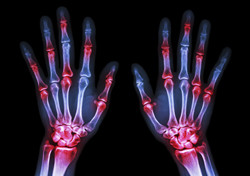A new era in osteoarthritis prognosis
OA is a degenerative disease of the joints that is associated with severe pain and disability. It is the most common form of disability in Europe and although the aetiology can vary, OA symptoms usually involve cartilage loss and bone sclerosis. Extreme cases of OA are treated with hip or joint replacement with important socioeconomic implications for European countries. Understanding the genetic basis of OA would not only help us understand OA pathogenesis, but could also lead to new, targeted therapies. Scientists on the EU-funded 'Translational research in Europe applied technologies for osteoarthritis' (TREAT OA)(opens in new window) project worked on developing better diagnostic and therapeutic options for OA. To this end, the consortium analysed the genotypes of thousands of OA cases. This led to the identification of single nucleotide polymorphisms that were strongly associated with knee OA, hip OA and hand OA. Among the genes tightly linked with OA development was DOT1L, which is implicated in cartilage metabolism and Wnt signalling and may be a therapeutic target. To study the identified genes in detail and also screen various therapeutic agents, researchers developed in vitro and in vivo OA models. These models served as invaluable tools for the investigation of various signalling pathways and the identification of molecular determinants of OA pathogenesis. Considerable effort went into the identification of novel biochemical markers that could be used to predict and diagnose OA progression. Currently, only two markers (hCOMP and CTX-II) are available. Combined with genetic data, these biochemical markers were utilised to study disease incidence, risk and severity in different European populations and to predict progression of knee OA. Clinical implementation of the TREAT OA diagnostic markers could identify individuals at high risk of developing OA and improve the overall disease outcome through prompt treatment. The project generated over 80 peer reviewed publications including articles in Lancet, Nature Genetics, Proc Natl Acad Sci and Am J Hum Genet.







